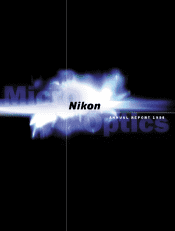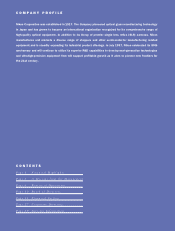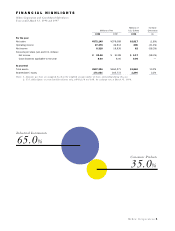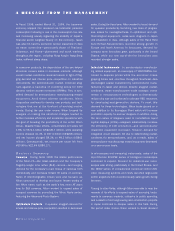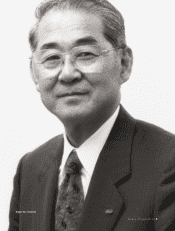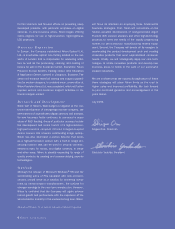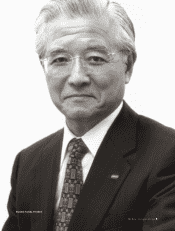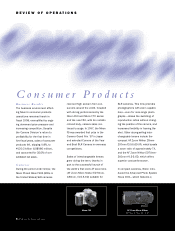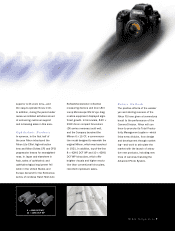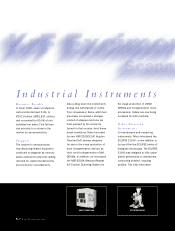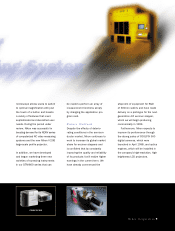Nikon 1998 Annual Report Download - page 4
Download and view the complete annual report
Please find page 4 of the 1998 Nikon annual report below. You can navigate through the pages in the report by either clicking on the pages listed below, or by using the keyword search tool below to find specific information within the annual report.
In fiscal 1998, ended March 31, 1998, the Japanese
economy slipped into recession as lackluster personal
consumption following a rise in the consumption tax rate
and increasing anxiety regarding the stability of Japan’s
financial sector weighed heavily on the economy. Japan
was also hit hard by economic turmoil elsewhere in Asia
as Asian currencies—particularly those of Thailand,
Indonesia, and Korea—plummeted and stock markets
throughout the region, including Hong Kong’s Hang Seng
Index, suffered steep drops.
In consumer products, the depreciation of the yen helped
stimulate camera sales in overseas markets, although
overall market conditions remained severe in light of flag-
ging demand and intense price competition. In industrial
instruments, the semiconductor market remained stag-
nant against a backdrop of crumbling prices for 16M
dynamic random access memories (DRAMs). This, in turn,
stifled demand for semiconductor manufacturing related
equipment. Amid these adverse conditions, Nikon
Corporation continued to develop new products and tech-
nologies that are at the forefront of evolving market
trends. During the year under review, Nikon focused its
energies on making the structural changes needed to
further increase efficiency and accelerate operations with
the goal of boosting the productivity of the entire Nikon
Group. Despite these efforts, consolidated net sales fell
1.8%, to ¥372.1 billion (US$2,817 million), while operating
income dropped 41.4%, to ¥27.5 billion (US$208 million),
and net income plunged 58.3%, to ¥8.3 billion (US$63
million). Consequently, net income per share fell from
¥53.89 to ¥22.48 (US$0.17).
Business Summary
Cameras During fiscal 1998, the stellar performance
of the Nikon F5—the latest addition and the Company’s
flagship single lens reflex (SLR) camera—and surging
demand for the Company’s main lineup of cameras both
domestically and overseas helped lift sales of cameras.
Sales of interchangeable lenses were also buoyant, as
Nikon continued to develop and launch lenses worthy of
the Nikon name, such as the world’s first micro AF zoom
lens for SLR cameras. Nikon worked to expand sales of
compact cameras by promoting the Nikon Nuvis series,
featuring the Advanced Photo System.
Ophthalmic Products In eyewear, sluggish demand for
lenses and intense price competition resulted in decreased
sales. During the fiscal year, Nikon worked to boost demand
for eyewear products by launching new lines of progres-
sive lenses for nearsightedness. In ophthalmic and oph-
thalmological equipment, sales were stagnant in Japan
and elsewhere in Asia, although sales of the Hand Held
Auto Refract-Keratometers recorded strong growth in
Europe and North America. In binoculars, demand for
compact zoom binoculars grew, particularly in the United
States, while our new top-of-the-line binoculars also
recorded stronger sales.
Industrial Instruments In semiconductor manufactur-
ing related equipment, an oversupply of 16M DRAMs con-
tinued to depress prices while the economic crises
gripping Korea and countries throughout Southeast Asia
discouraged capital investment by semiconductor manu-
facturers in Japan and abroad. Despite sluggish market
conditions, these manufacturers made strategic invest-
ments in miniaturization technologies to dramatically
reduce chip size and continued to allocate R&D resources
for developing next-generation devices. To meet this
demand for these technologies, Nikon broke ground on a
new addition to its Kumagaya Plant which will increase
production capacity for excimer steppers. In addition, during
the term sales of steppers used to manufacture liquid
crystal displays (LCDs)—steppers substantially increase
the efficiency of LCD production—and semiconductor
inspection equipment increased. However, demand for
integrated circuit steppers fell due to deteriorating market
conditions for semiconductors, and, as a result, sales of
semiconductor manufacturing related equipment decreased
on a year-on-year basis.
In microscopes and measuring instruments, sales of the
top-of-the-line ECLIPSE series of biological microscopes
continued to expand. Demand for industrial-use micro-
scopes was strong, particularly in the United States, and
the NEXIV series of computerized numerical control (NC)
video measuring systems and newly launched large-scale
profile projectors both recorded steady sales growth during
the term.
Turning to other fields, although Nikon was able to reap the
rewards of its efforts to expand sales of surveying instru-
ments in overseas markets, cutbacks in public spending
and a dearth of civil engineering and construction projects
in Japan continued to hamper sales in this field. During
the period under review, Nikon worked to boost demand
2Nikon Corporation
A MESSAGE FROM THE MANAGEMENT
QX /NIKON AR 98 9/21 00.4.11 3:40 PM ページ 2

